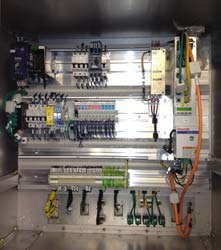
Posted to News on 18th Apr 2013, 10:33
Capacitance modules are an easy route to energy efficiency
Andrew Davies of Bosch Rexroth explains how capacitance modules can be an easy and cost-effective way to improve the energy efficiency of machines.

The issue of energy saving has traditionally never been a high priority for machine builders. However, with escalating energy prices there is increasing pressure for energy-saving options to be fitted to industrial machinery in order to help mitigate the impact of rising energy prices for end users.
One way of achieving this is to use simple capacitance modules to improve the energy balance in applications where machining cycles take place in rapid succession, such as roll feeds or cross-cutting lines.
Effectively, the capacitance module acts like a kinetic energy recovery system (KERS) on a Formula 1 car. The KERS recovers a moving vehicle's kinetic energy under braking, stores it in a flywheel or a battery, enabling it to be released later to boost acceleration.
With a capacitance module, which is connected to the DC bus, the machine effectively has a temporary energy storage unit that can reduce the heat loss in the control cabinet by relieving the braking resistor. The primary role of the capacitance module is to enable a controlled retraction motion in the event of a power failure. This protects the workpiece and the tool - for example, in gear cutting machines.

In recent years, Bosch Rexroth has worked extensively with Henrob, the global manufacturers of self-piercing riveting equipment, to introduce capacitance modules into a number of the company's machines. This has enabled both parties to analyse the impact of capacitance modules in actual production environments.
Below is a breakdown of costs using 500 capacitance modules on a vehicle production line that requires the driven load to stop very quickly. As shown, during an average cycle, 1.3A is used at 400V, and it takes 1.6 seconds to set each rivet. With a capacitance module in use, the energy saving is 13.36 per cent.

During the course of a typical production day, 500 cars are assembled, each with 3000 rivets; this equates to 1,500,000 rivets per day and an energy consumption of 14056.25kWH per day - costing 1686.75.
The saving from the capacitance module equates to 225 per day; over a twelve-month period, this delivers a saving of more than 54,000. Ultimately, the use of a capacitance module in this automotive application had a payback period of 2.64 years.
It is clear, therefore, that capacitance modules can play a significant role in helping to save energy and cut costs in machinery applications. Crucially, capacitance modules have a relatively low unit price and can therefore offer a short payback period.
Contact Bosch Rexroth for more information about capacitance modules and to enquire about specific applications.






























